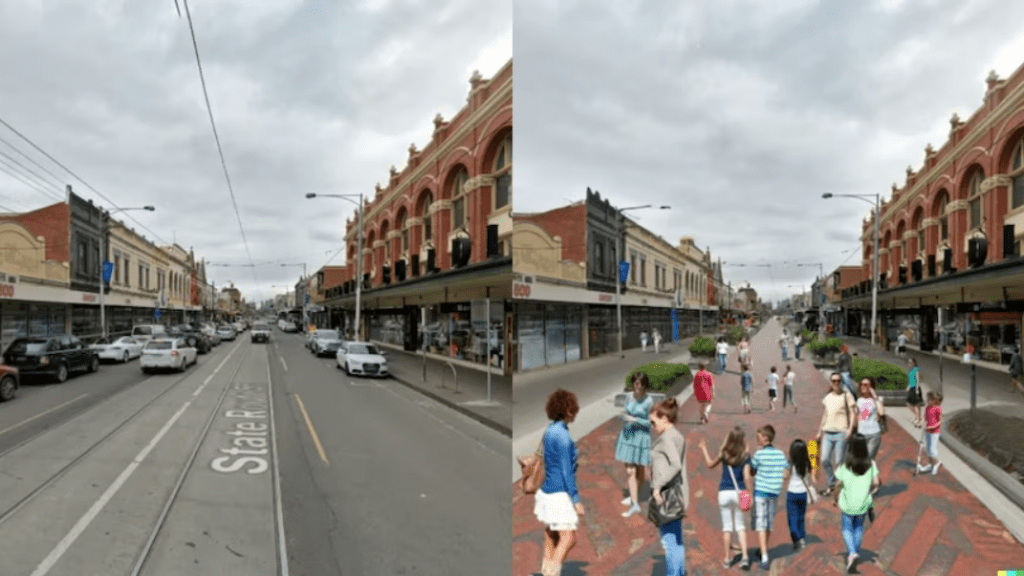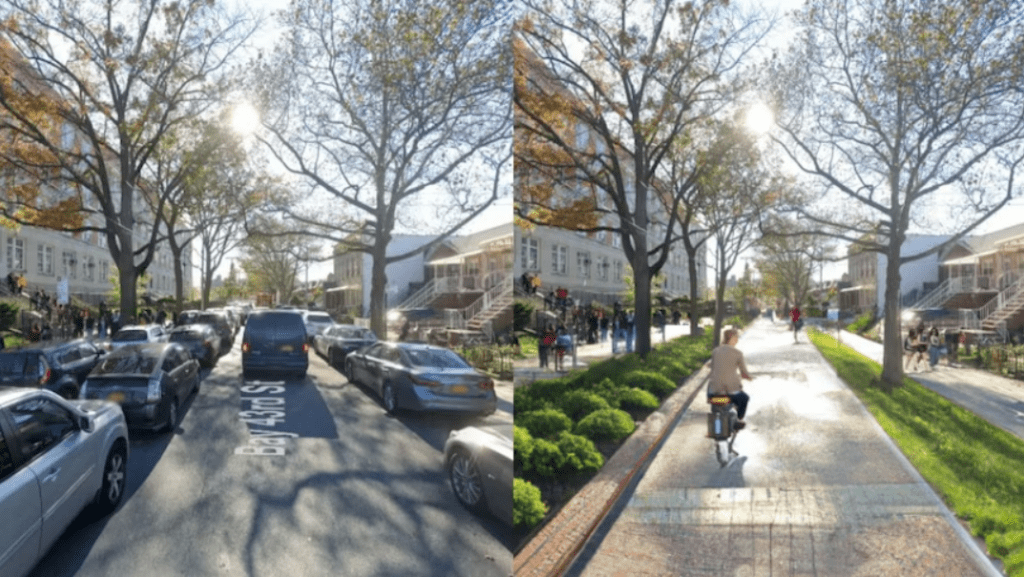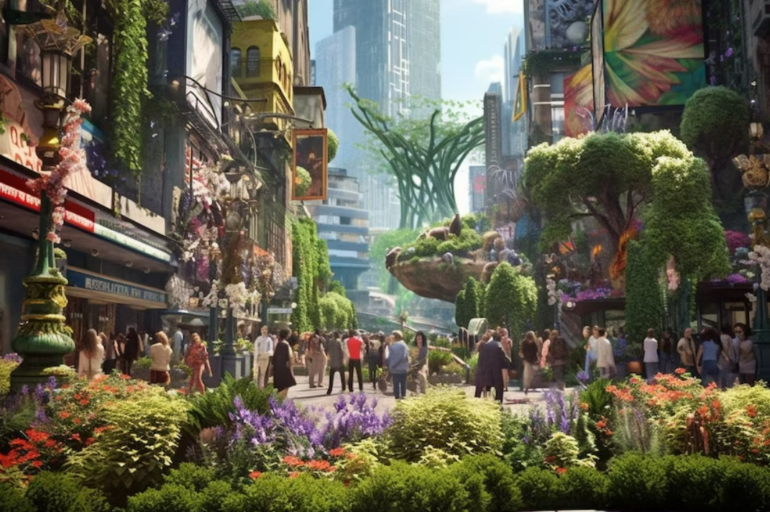TL;DR:
- Zach Katz utilizes emerging AI tools to envision and bring to life enhanced versions of streets.
- Katz started by transforming his own Brooklyn neighborhood and received numerous requests from people worldwide.
- He uses the AI system DALL-E to modify street images by erasing elements and providing prompts for AI guidance.
- Hank Haeusler, an associate professor, emphasizes the importance of AI in adapting streets for climate change resilience.
- Haeusler believes AI can help address challenges like urban heat and flooding by incorporating green spaces.
- Advanced computational tools enable rapid assessment of design impacts and facilitate informed decision-making.
- Katz’s goal is to inspire individuals, including government officials, urban planners, activists, and artists, to envision better streets.
- Katz’s street transformations exemplify the transformative role of AI in shaping urban landscapes.
Main AI News:
When Zach Katz casts his discerning gaze upon the world, his artistic sensibilities awaken, envisioning a “more beautiful” rendition of his surroundings. However, instead of employing traditional tools like paintbrushes or clay, Katz harnesses the power of emerging artificial intelligence (AI) technologies to bring these enhanced versions to life.
As the visionary behind BetterStreetsAI, Katz initially delved into image-based AI programs to metamorphose his own Brooklyn neighborhood in New York. He reminisces, “I began with capturing photos of my street here in Brooklyn and transformed it into a vibrant pedestrian promenade, complete with a serene water fountain and children engrossed in playful activities. The result was undeniably captivating.“
Katz possesses an innate ability to perceive the untapped potential of every street, envisioning them as more people-centric and less car-centric. He emphasizes, “Whenever I gaze upon a street, I can effortlessly discern its latent beauty, its capacity for transformation. And with the aid of technology, I can vividly visualize these possibilities.”
Despite lacking a formal background in urban design or planning, Katz draws from the principles of 21st-century urban planning, honed during his time residing in Amsterdam. He asserts, “It’s not an arcane science. By simply reallocating space from cars, one can create a remarkable street.”
After sharing his street transformations online, Katz was inundated with requests from individuals worldwide, yearning for their neighborhoods to undergo a similar makeover. Reflecting on this overwhelming response, he remarks, “While I received thousands of requests, I ultimately followed my creative instincts and worked on projects that truly resonate with me. So, I delve into Google Maps, select a city, and explore until I discover a street brimming with transformation potential.”
To accomplish his ambitious endeavors, Katz leverages an AI system known as DALL-E, a sibling to ChatGPT renowned for its ability to generate or modify visuals based on language input. Transforming streets, however, demands a considerable amount of Katz’s own effort and artistry. “It’s a meticulous process, akin to creating any form of art, and it necessitates a clear vision to guide the AI in the desired direction,” he explains. The current workflow involves uploading an existing street photograph, selectively erasing certain elements, and employing prompts to guide the AI program in filling the voids.

The imagined transformations of existing streets, like this treatment of Sydney Road in Brunswick, often add people. Source: Better Streets AI
Katz attests that understanding how the AI program responds to specific prompts is an art form in itself. He remarks, “The phrases ‘car-free street’ and ‘pedestrian promenade’ can yield vastly different outcomes. Mastering the intricacies of these phrase-driven results constituted a significant part of my learning curve.” While AI can occasionally generate remarkable outputs independently, Katz finds intentional guidance consistently produces superior results.
The Potential of AI in Adapting Urban Environments for Climate Change
Hank Haeusler, an associate professor at the University of New South Wales specializing in arts, design, and architecture, acknowledges the importance of AI in urban design within the Australian context. However, he offers a divergent perspective on Katz’s project, considering it primarily a visual art practice with limited practical utility in real-world planning.
Haeusler contends that the paramount challenge facing Australian cities is climate change. He advocates for the nuanced application of AI technology to adapt streets and facilitate resilience against extreme weather events such as heatwaves and flooding. Urgency underpins his message as he states, “Time is of the essence. With recent floods, bushfires, and scorching heatwaves, we must act swiftly.”
According to Haeusler, concrete-laden cities exacerbate the urban heat phenomenon, with excessive heat retention leading to the formation of heat islands. He explains, “A profusion of concrete surfaces prevents water from infiltrating the ground, resulting in runoff that overwhelms sewage systems and rivers, causing flooding.”
To combat these challenges, incorporating green spaces into urban environments emerges as a pivotal strategy, as emphasized by Dr. Haeusler. He emphasizes that leveraging advanced computational tools can expedite the process of designing streets to address heat and flooding issues. By conducting simulations and assessments, urban designers and councils gain rapid insights into the potential impacts of incorporating elements such as trees or alternative paving materials.




The imagined transformations of existing streets, like this treatment of Sydney Road in Brunswick, often add people. Source: Better Streets AI
The advent of AI-enabled tools equips designers with swift access to invaluable information, empowering them to make informed decisions promptly. Dr. Haeusler envisions a future where streets can be designed, redesigned, and assessed for sustainability measures at an accelerated pace. Gone are the days of ponderous deliberations about concrete substitution or tree planting locations—AI streamlines the decision-making process, ensuring data-driven efficiency.
For Katz, his street transformations serve as a catalyst, employing technology as a means to inspire individuals from all walks of life to envision optimal versions of public spaces. Whether it’s government officials, urban planners, activists, or artists, Katz’s goal remains unchanged: “To showcase the vast potential for improving our streets.” The stark contrast between the before and after images resonate profoundly, leaving no doubt as to which version represents a more desirable place to reside.
Conlcusion:
The utilization of emerging AI tools and technologies, as demonstrated by Zach Katz’s street transformations, holds significant implications for the market. By showcasing the potential of AI in envisioning and enhancing public spaces, there are opportunities for businesses operating in the urban design, architecture, and AI sectors. This highlights the growing demand for innovative solutions that can transform streets and urban environments, not only for aesthetic purposes but also to address pressing challenges such as climate change resilience.
The market can expect increased interest in AI-driven urban planning, computational tools, and design services that facilitate rapid decision-making and sustainable transformations. As cities strive for more people-centric and resilient urban landscapes, businesses that can effectively harness AI’s transformative capabilities are well-positioned to seize emerging market opportunities and drive positive change in the built environment.

